Mumbai’s Chatterjee and Lal and New York’s Aicon Gallery talk to us about their upcoming gallery swap and why it’s a refreshing change from art fairs
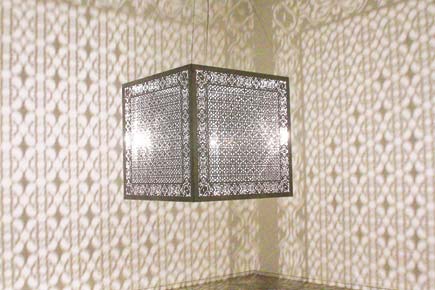
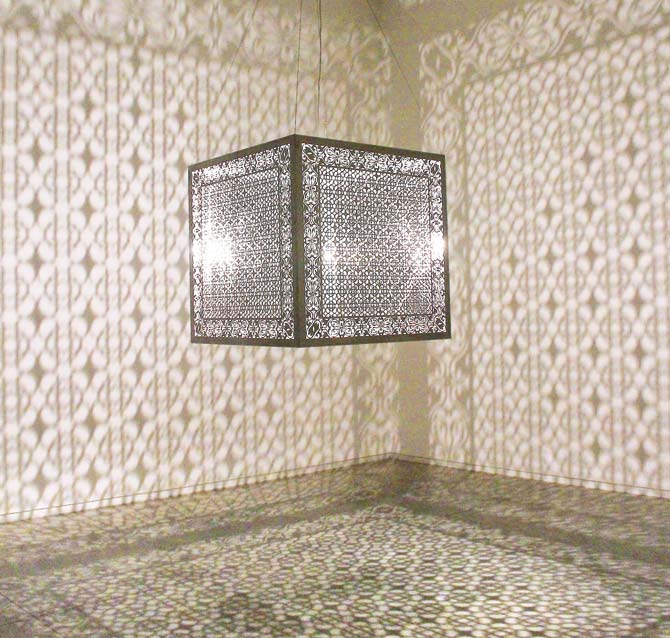 Contemporary artist Anila Quayyum Agha’s laser-cut stainless steel cube, Hidden Diamond (2016). Pics/AICON gallery
Contemporary artist Anila Quayyum Agha’s laser-cut stainless steel cube, Hidden Diamond (2016). Pics/AICON gallery
In June 2008, contemporary artist Nikhil Chopra took on the garb of Sir Raja, a fictional character and landscape painter, and traversed the streets, parks and subways of Manhattan and Brooklyn in a personal attempt to map the city.
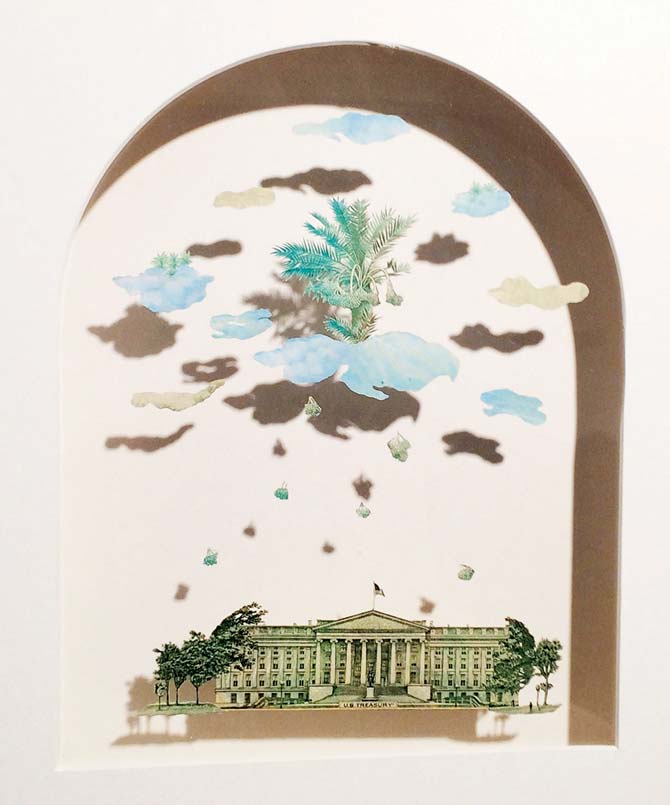
Abdullah M. I. Syed’s Heavenly Offerings — I, 2016, made of hand-cut UAE Dirham banknotes and U.S. bills in a shadow-box
Titled Sir Raja III Visits New York City, the performance followed an earlier piece by Chopra at Colaba’s Chatterjee and Lal in 2007, in which he transformed into Yog Raj Chitrakar, a character loosely based on his grandfather. Sir Raja and Yog Raj Chitrakar have since then travelled across continents and the New York performance was part of a strategic gallery exchange between Chatterjee and Lal and Thomas Erben Gallery. For two weeks only, in mid-2008, the galleries switched places across shores, working collaboratively and bringing their artists into each other’s spaces and cities.
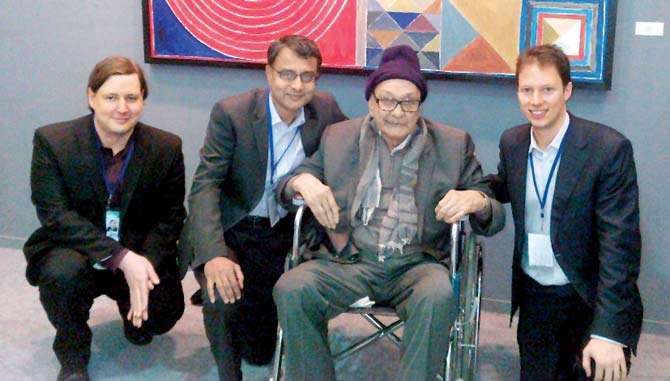
(From left) Andrew Shea, Prajit Dutta, SH Raza and Harry Hutchison
It was the first time that gallerists Mortimer Chatterjee and Tara Lal had attempted the switch in a format that has proven so successful for them that they are set to repeat it this month with Aicon Gallery, New York.
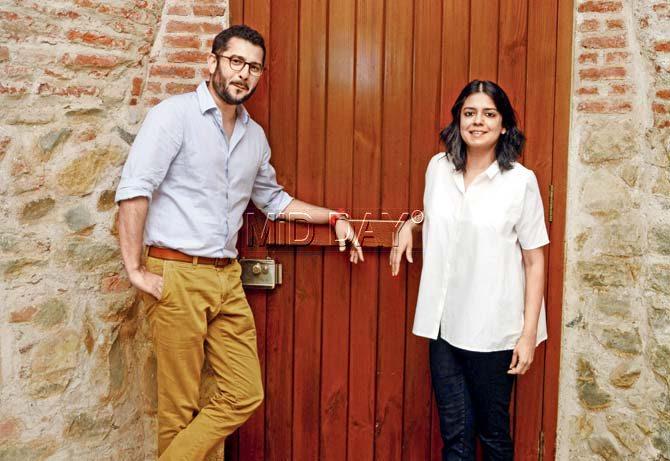
Gallerists Mortimer Chatterjee and Tara Lal. Pic/Bipin Kokate
A likeminded collaborator
The concept of the gallery swap has been around for some time now but not one that has found too many takers world over. So, what’s in it for galleries that do sign up for a swap? “Presenting an exhibition this way, we can really set down roots in a new city,” says Chatterjee.
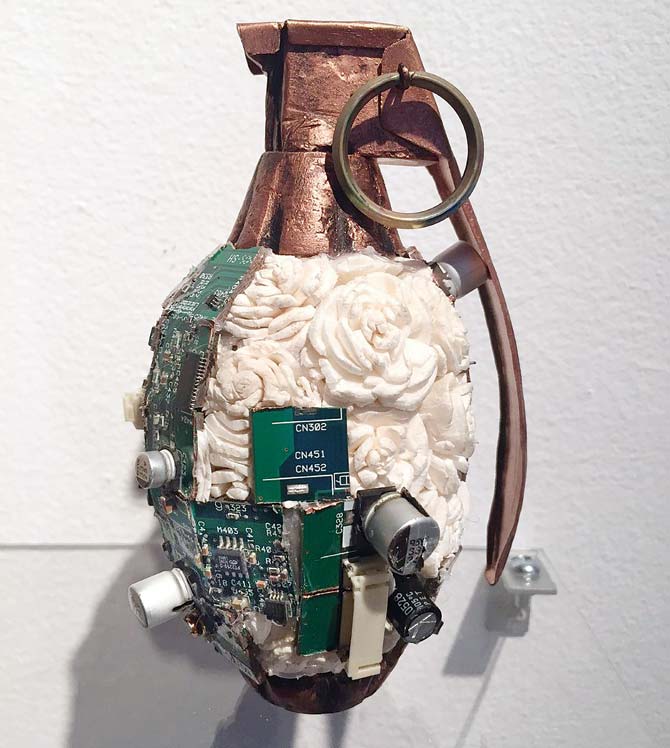
Grenade 3 by Promotesh Das Pulak
Aicon Gallery’s two-week-long exhibition, titled Delicate Bond of Steel, opens on November 9 at Chatterjee and Lal; in turn, the Colaba gallery will present a show at Aicon Gallery slated for 2017.

Performance artist Nikhil Chopra enacts Sir Raja III Visits New York City at Thomas Erben Gallery in 2008. PIC/Chatterjee & Lal
Founded in 2002 by brothers Projjal and Prajit Dutta, Aicon Gallery is known for representing modern and contemporary artists from South Asia, the Middle East and the diaspora from the subcontinent. Delicate Bond of Steel will feature artists that the gallery has worked with over the years, including Anila Quayyum Agha, Abir Karmakar, Baiju Parthan and the late Rajan Krishnan, to whose memory the exhibition is dedicated. “The show is in response to sectarian strife and regional conflict the world over. Through the curation of this show, we are proposing a cultural solidarity,” says the curator, Andrew Shea. The title of the show was developed by Projjal Dutta from Agha’s laser-cut stainless steel cubes.
The curation should resonate well with Mumbai audiences, which the gallery is reaching out to for the first time. But, it’s hardly virgin territory for Aicon Gallery, which routinely participates in art fairs, including the India Art Fair in New Delhi. “But art fairs are a completely different format. While we curate the booth, art fairs, by nature, tend to draw tourists and can be chaotic,” says Shea. The purpose and pleasure of bringing a show to foreign shores in a gallery is to offer a contemplative space for visitors, free from the excesses of art fairs, he adds.
Chatterjee is of a similar line of thought, when he speaks about the “cookie cutter format” of art fairs, which ensures a uniformity in terms of the lighting and floor space.
With their second gallery swap, Chatterjee and Lal are positing this format as an alternative to the art fair model. It is more enriching than merely renting a gallery in a new city. Harry Hutchison, the director of Aicon Gallery — who has earlier worked with an auction house in Mumbai — says, “No money is exchanged between galleries. This is not a pop-up show but a full-fledged exhibition. We hope to reach out to a whole city’s worth of art lovers.”
Developing a base
Planning the swap, both galleries have been in talks for almost a year. Each gallery will now offer its resources well beyond the space — their connections, press contacts and collector networks are mutually shared. “At the meta-level, we are letting the city know about Aicon Gallery; at a more focussed level, we are letting our collectors know about the show,” says Chatterjee.
With collector bases nurtured over the years, could there be a potential conflict of interest in a gallery swap? Chatterjee is sceptical of such a situation arising. “The reality is that Indian contemporary art is at a nascent stage and there aren’t hundreds of collectors, but just about 60 or so. Perhaps at a different time or place there could be: but not in the Mumbai of 2016. Thus, there are several commonalities across what collectors are interested in,” he says.
While the prospect of teleporting shows into new territory is exciting, it does not come without challenges. Shea’s careful curation ensures that the works come with ease of installation. Even Agha’s three feet by three feet cube can be set up with limited resources. “We are aware that we don’t have the luxury of spending a week on setting up the exhibition,” says Shea.
When Chatterjee and Lal venture to Aicon Gallery next year, the have the task of bridging the gap. Chatterjee says, “Mainland Europe has more exposure to South Asian art than New York, which has historically been a tough audience. So, we have to consider that what’s working in Mumbai need not in New York.”
At Delicate Bond of Steel, Mumbai will get to see Abir Karmakar’s visual comments on spying, Promotesh Das Pulak’s strange ammunition and Agha’s lattice cube, among others. Agha’s pieces are usually displayed solely so that their intricate lattice-work casts unhindered shadows. In this show, the cube is going to hang in close proximity with other works. “The beauty of showing a work like that in a gallery space, as opposed to a museum, is that it is inevitable to experience unforeseen visual resonances between works as an outcome of light spill and sound spill. Artists often enjoy this and tend to roll with it,”says Chatterjee.
 Subscribe today by clicking the link and stay updated with the latest news!" Click here!
Subscribe today by clicking the link and stay updated with the latest news!" Click here!









